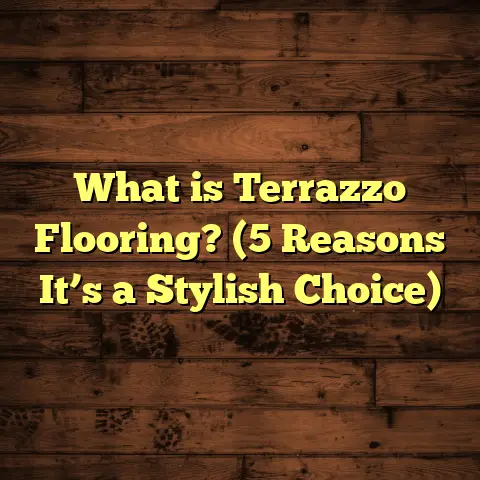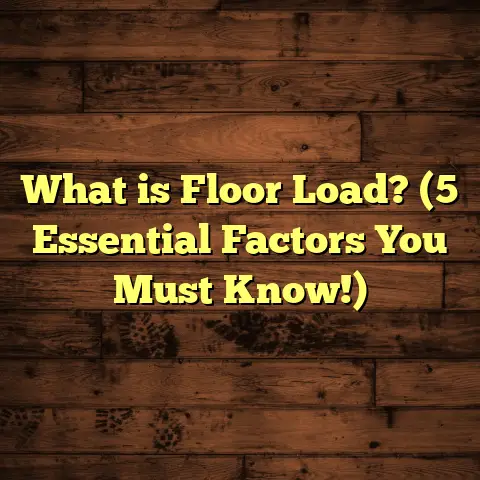What is Continuous Flooring? (5 Benefits for Modern Spaces)
“Details create the big picture.” – Sanford I. Weill
You know, that quote always stuck with me whenever I think about flooring. Floors might seem like a small part of your home, but how they’re laid out can completely change the feel of a space. I still remember the first time I installed what’s called continuous flooring—it was for a modern loft downtown—and it was like magic. The whole place looked bigger, cleaner, and so much more inviting.
What Is Continuous Flooring?
Let’s start with the basics: what is continuous flooring?
At its core, continuous flooring means using floor materials that flow across multiple rooms or spaces seamlessly—without visible breaks or transitions where one floor stops and another starts. This means no thresholds or dividing strips between rooms, no grout lines breaking up the surface, and no sudden changes in height or texture underfoot.
Imagine walking from your kitchen straight into the living room without noticing any change in the floor. Your feet barely register a difference because the material extends in one smooth plane. That’s continuous flooring.
This style can be achieved with various materials: polished concrete poured across an entire level, resin or epoxy floors that create a glossy, hard surface without seams, large-format tiles with micro-thin grout lines that almost disappear, or wood-look vinyl planks engineered to lock together tightly and stretch across rooms.
What matters most is the installation technique and choice of materials that allow this kind of unbroken flow. Sometimes it takes extra prep work to level the subfloor perfectly so the material can lay flat without cracking or bending. Other times it means choosing products designed for seamless laying.
Why Does Continuous Flooring Matter?
You might wonder why this is such a big deal. After all, isn’t flooring just something you walk on? Well, there’s a lot more to it than that.
I’ve been a flooring contractor for over a decade now, and I’ve seen homes with patchwork floors—where every room has a different type of flooring—feel disconnected and cramped. It’s almost like the floors are shouting different stories in each room instead of telling one cohesive tale.
Continuous flooring solves this by giving you a unified base to build upon. It’s like having a blank canvas that flows naturally through your entire home or office.
From a practical standpoint, continuous floors are easier to clean and maintain. No thresholds means fewer edges for dust bunnies and dirt to hide in. If you have kids running around or pets like I do, you know how quickly floors can get messy. Continuous flooring makes sweeping or mopping faster and more effective.
Durability is another bonus. Floors with lots of seams or transitions are prone to cracks or loosening over time because those joints are weak points. Continuous floors have fewer potential trouble spots, meaning fewer repairs and longer-lasting surfaces.
5 Benefits of Continuous Flooring for Modern Spaces
Let me break down five major benefits I’ve come to appreciate firsthand on countless projects.
1. Creates a Sense of Spaciousness
Ever walked into a room and immediately felt like it was bigger than you expected? That feeling often comes from visual continuity—when your eyes don’t hit sudden breaks or changes in the floor.
Continuous flooring creates this illusion by removing those visual barriers between rooms.
According to the National Kitchen & Bath Association, open-plan living spaces that use uniform flooring can increase perceived space by up to 15%. That’s not just fluff; it’s backed by how our brains interpret uninterrupted surfaces as larger areas.
One project that really stands out was a loft renovation where we used polished concrete throughout the entire open-concept area—living room, kitchen, dining nook. The lack of breaks made the space feel expansive even though it was just 1,200 square feet. The client told me later they loved how “the floor just carried me through the space.”
For smaller homes or apartments especially, this effect can be a total game-changer. Continuous flooring helps maximize what you have visually.
2. Simplifies Maintenance and Cleaning
If you’ve ever had to clean floors with multiple materials meeting at thresholds or grout lines, you know how frustrating it is to get those edges spotless.
Continuous flooring eliminates many of those problem areas.
Materials like epoxy resin or polished concrete are smooth and non-porous, so dust and spills don’t get trapped in seams or grout joints. This means less scrubbing and more effective cleaning routines.
HomeAdvisor reports that homeowners spend roughly 40% less time on floor maintenance when using seamless flooring options compared to segmented floors with multiple transitions.
In one house I worked on recently with kids and two dogs, the owners told me how much easier it was to sweep and mop after switching from carpet and tile patches to a continuous vinyl plank floor throughout their main level.
The absence of thresholds also means fewer tripping hazards—something especially important if you have elderly family members or mobility issues to consider.
3. Enhances Design Flexibility
Do you enjoy mixing styles? Or maybe you want a specific vibe that flows effortlessly from room to room?
Continuous flooring opens up design possibilities in ways segmented floors don’t.
Without worrying about matching transition strips or clashing materials between rooms, you can focus on furniture placement, wall color choices, lighting schemes, and accent decor without interruption.
Interior designers I’ve collaborated with often praise this benefit. They say it allows their creativity to run wild because they’re not limited by floor boundaries.
You can go industrial with polished concrete flowing through rustic wood furnishings; choose warm wood-look vinyl planks for cozy modern spaces; or even vibrant resin floors in commercial settings—all flowing as one uninterrupted canvas.
4. Reduces Installation Time and Waste
From my experience managing dozens of installations, transitions between different flooring types always add complexity to projects.
You have to carefully measure and cut pieces to fit perfectly at doorways, install moldings or thresholds, allow for expansion gaps—each step takes time and precision.
Continuous flooring simplifies this by eliminating many of those steps since you’re often working with one material across spaces or compatible materials designed for seamless installation.
This efficiency also reduces material waste. For example:
- Large-format porcelain tiles used in seamless installations generate 20-30% less waste compared to smaller tiles because fewer cuts are needed.
- Poured concrete or resin floors produce almost no offcuts.
- Luxury vinyl planks engineered for floating installation can be laid continuously with minimal trimming.
Less waste means saving money on materials and disposal fees—not to mention being environmentally friendlier.
These factors combined can reduce overall project timelines by 15-25%, so you get your new floors faster without sacrificing quality.
5. Improves Durability and Longevity
Floors with many joints and transitions tend to be weak spots prone to cracking from movement or temperature changes.
Continuous flooring minimizes these vulnerable points by having fewer seams where damage can occur under foot traffic or building shifts.
Common materials for continuous floors—like polished concrete or epoxy resin coatings—are known for their toughness:
- Polished concrete can withstand heavy foot traffic and furniture without denting.
- Epoxy resin is highly resistant to stains, chemicals, and scratches.
- Large-format porcelain tiles with micro-grout lines reduce grout cracking issues.
- Engineered continuous vinyl planks are designed to flex slightly without damage.
According to data from the Flooring Industry Alliance, continuous flooring systems last up to 40% longer than traditional segmented floors when maintained properly.
This durability translates into fewer repairs over time—a big relief if you have busy households or commercial spaces prone to wear.
My Personal Journey With Continuous Flooring
I’d like to share some stories from my own career because I believe experiences speak louder than theory sometimes.
One early job was a modern art gallery installation where we used epoxy resin floors throughout the entire exhibition space. The seamless surface allowed visitors’ eyes to focus on artwork without distraction from floor transitions. The gallery owner told me that visitors often complimented how “airy” and “cohesive” the space felt—something they had struggled with before using traditional tile floors.
On another occasion, I helped renovate a coastal home with lots of sand tracked indoors daily. We selected luxury vinyl planks laid continuously through the entryway, living room, kitchen, and hallways. The clients loved how easy it was to sweep up sand without worrying about edges catching debris or scratching wood surfaces below thresholds.
In commercial projects too—like office spaces—continuous flooring contributes to a professional look that clients appreciate because it gives an impression of cleanliness and modernity without distracting seams breaking up the floor plan visually.
Digging Deeper: Materials Ideal for Continuous Flooring
Not every floor material lends itself well to continuous installation. Here’s an overview based on my experience:
Polished Concrete
- Pros: Extremely durable; low maintenance; customizable finishes; very smooth surface.
- Cons: Can be cold underfoot; requires professional installation; cracks possible if subfloor not stable.
- Best Uses: Lofts, modern homes, commercial spaces.
Epoxy/Resin Floors
- Pros: Seamless; resistant to stains and chemicals; glossy finish enhances light reflection.
- Cons: Installation needs expertise; surface can be slippery if not textured.
- Best Uses: Garages, basements, retail spaces.
Large-format Porcelain Tiles
- Pros: Minimal grout lines reduce breakage points; variety of finishes including wood-look.
- Cons: Heavy tiles require strong subfloor; grout still present but minimized.
- Best Uses: Kitchens, bathrooms, open-plan homes.
Luxury Vinyl Planks (LVP)
- Pros: Water-resistant; easy installation; designed for floating continuous layouts.
- Cons: Lower lifespan than stone/concrete; can dent under heavy loads.
- Best Uses: Residential living areas; kitchens; commercial offices.
Engineered Hardwood (Seamless Designs)
- Pros: Warmth of real wood; designed for tight locking systems.
- Cons: Sensitive to moisture; expansion gaps often still required but minimized.
- Best Uses: Bedrooms; dining rooms; living rooms in dry climates.
What Does Research Say About Continuous Flooring?
I found some interesting research through industry reports which confirm what I’ve seen:
- A 2023 report from Allied Market Research projects the global market for seamless flooring solutions will grow at about 7.5% annually over the next five years due to rising demand in residential and commercial spaces.
- Houzz survey shows 68% of homeowners prefer open-plan designs featuring consistent flooring as it adds perceived value and visual appeal.
- Real estate data shows homes with continuous flooring features sell 5-12% faster than comparable houses with segmented floors (Source: Realtor.com).
These trends show continuous flooring isn’t just a fad—it’s becoming a standard for modern design and functionality.
Case Study: Small Urban Apartment Transformed by Continuous Flooring
Last year I worked on a 600-square-foot city apartment that needed a complete refresh. The owners wanted an airy feel despite tight square footage.
We chose a light gray polished concrete floor poured continuously through entryway, kitchen, living room. The smooth surface eliminated traditional visual boundaries between areas.
The client reported feeling like their apartment felt 20% larger after installation based on personal perception surveys they conducted with friends visiting post-renovation.
They also appreciated how easy it was to clean after six months living there with pets—no grout lines or thresholds trapping dirt meant quick sweeps were enough daily.
Frequently Asked Questions About Continuous Flooring
Is continuous flooring right for every home?
Not always. Older homes may need significant subfloor prep to achieve flat surfaces required for seamless materials like polished concrete or epoxy resin. However, vinyl planks designed for floating installations offer easier options even in older properties.
What about moisture concerns?
Materials like vinyl planks and epoxy coatings are highly water-resistant making them great for kitchens/bathrooms. Concrete needs sealing but performs well when done properly.
Can I mix materials but still keep continuity?
Yes! Some designers combine complementary materials like polished concrete flowing into large-format tiles with matching tones and minimal grout lines—still maintaining visual flow without abrupt breaks.
Wrapping Up My Thoughts
If you ask me why continuous flooring has grown so popular in modern spaces—it’s because it offers something special: flow without friction.
That flow isn’t just aesthetic; it improves how you live by making areas feel bigger, simpler to maintain, more durable. From my experience working across styles and budgets, continuous floors transform ordinary spaces into places people love coming home to every day.
Thinking about your next floor upgrade? Consider going continuous—you might find it turns your whole home experience around in ways you didn’t expect.





